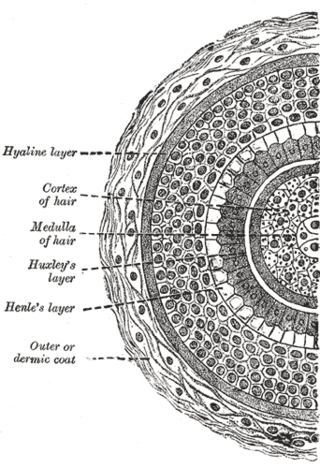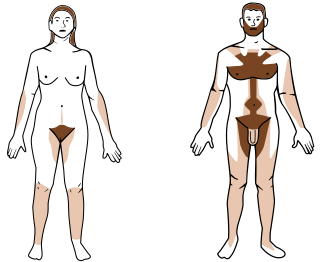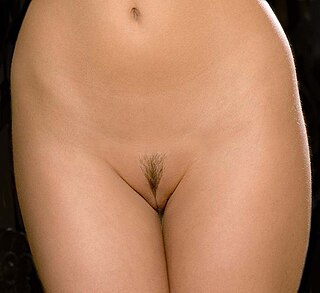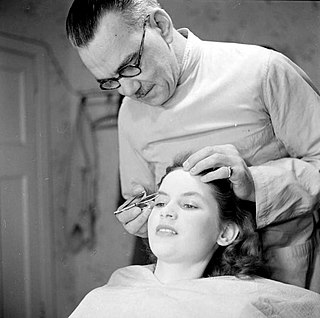
Hair is a protein filament that grows from follicles found in the dermis. Hair is one of the defining characteristics of mammals. The human body, apart from areas of glabrous skin, is covered in follicles which produce thick terminal and fine vellus hair. Most common interest in hair is focused on hair growth, hair types, and hair care, but hair is also an important biomaterial primarily composed of protein, notably alpha-keratin.

Electrology is the practice of electrical hair removal to permanently remove human hair from the body. Electrolysis is the actual process of removing hair using electricity.

Pubic hair is terminal body hair that is found in the genital area of adolescent and adult humans. The hair is located on and around the sex organs and sometimes at the top of the inside of the thighs. In the pubic region around the pubis bone and the mons pubis that covers it, it is known as a pubic patch. Pubic hair is also found on the scrotum and base of the penile shaft in males and on the vulva in females.

Hair removal, also known as epilation or depilation, is the deliberate removal of body hair or head hair.

Shaving is the removal of hair, by using a razor or any other kind of bladed implement, to slice it down—to the level of the skin or otherwise. Shaving is most commonly practiced by men to remove their facial hair and by women to remove their leg and underarm hair. A man is called clean-shaven if he has had his beard entirely removed.
Male waxing is the broad term for hair removal for men using depilatory wax. Within the beauty industry, it is common to see the more specific definitions 'male body waxing' and 'male Brazilian waxing'.

An eyebrow is an area of short hairs above each eye that follows the shape of the lower margin of the brow ridges of some mammals. In humans, eyebrows serve two main functions: first, communication through facial expression, and second, prevention of sweat, water, and other debris from falling down into the eye socket. It is common for people to modify their eyebrows by means of hair removal and makeup.

Bikini waxing is the removal of pubic hair using a special wax, which can be hot or cold, that adheres to hairs and pulls them out when the wax is removed quickly from the skin, usually with a cloth strip. While the practice is mainly associated with women, male waxing has become a more common practice to remove men's pubic hair.

Laser hair removal is the process of hair removal by means of exposure to pulses of laser light that destroy the hair follicle. It had been performed experimentally for about twenty years before becoming commercially available in 1995–1996. One of the first published articles describing laser hair removal was authored by the group at Massachusetts General Hospital in 1998. Laser hair removal is widely practiced in clinics, and even in homes using devices designed and priced for consumer self-treatment. Many reviews of laser hair removal methods, safety, and efficacy have been published in the dermatology literature.

Pseudofolliculitis barbae (PFB) is a type of irritant folliculitis that commonly affects people who have curly or coarse facial hair. It occurs when hair curls back into the skin after shaving, causing inflammation, redness, and bumps. This can lead to ingrown hairs, scarring, and skin discoloration. PFB can be treated with various methods, including changing shaving habits, using topical creams or ointments, and undergoing laser hair removal. Prevention measures include proper shaving techniques, using sharp razors, and avoiding too close a shave.
Sugaring, sugar waxing, or Persian waxing is a method of hair removal that has been in use since 1900 BC. Historically, sugar was confined to the regions surrounding Persia until the first millennium AD. As a result, it is speculated that honey was the first sugaring agent. Sugaring was also known as sukkar or ḥalawa in the Middle East, as ağda in Turkey, and as moum in Iran.

Hair transplantation is a surgical technique that removes hair follicles from one part of the body, called the 'donor site', to a bald or balding part of the body known as the 'recipient site'. The technique is primarily used to treat male pattern baldness. In this minimally invasive procedure, grafts containing hair follicles that are genetically resistant to balding are transplanted to the bald scalp.

In cosmetology, exfoliation is the removal of the surface skin cells and built-up dirt from the skin's surface. The term comes from the Latin word exfoliare. This is a regular practice within the cosmetic industry, both for its outcome of promoting skin regeneration as well as providing a deep cleanse of the skin barrier. Being used in facials, this process can be achieved by mechanical or chemical means, such as microdermabrasion or chemical peels. Exfoliants are advertised as treatments that enhance beauty and promote a youthful and healthy appearance.

An epilator is an electrical device used to remove hair by mechanically grasping multiple hairs simultaneously and pulling them out. The way in which epilators pull out hair is similar to waxing, but unlike waxing, they do not remove skin cells. Epilators may use an electric motor or be manually powered with a spring. They may also come with various attachments, like a smaller head to help with epilation of hard-to-reach areas, or an exfoliation head that may help exfoliate the skin before and after epilation.

Veet, formerly called Neet and Immac, is a Canadian brand of chemical depilatory products manufactured by the British-Dutch company Reckitt Benckiser. Hair removal cream, Lotions, gel, mousse, and wax products are produced under this brand, with differing variants being sold internationally. Previous products produced under the Neet and Immac brands were similar to those produced today.

Horse grooming is hygienic care given to a horse, or a process by which the horse's physical appearance is enhanced for horse shows or other types of competition.

Plucking or tweezing can mean the process of human hair removal, removing animal hair or a bird's feathers by mechanically pulling the item from the owner's body. In humans, hair removal is done for personal grooming purposes, usually with tweezers. An epilator is a motorised hair plucker. Those under the influence of deliriants or trichotillomania may pluck their own hair out of habit.
Body grooming is the act of maintaining a clean appearance. It is typically associated with hair.

Prepubertal hypertrichosis, also known as childhood hypertrichosis, is a cutaneous condition characterized by increased hair growth, found in otherwise healthy infants and children. Prepubertal hypertrichosis is a cosmetic condition and does not affect any other health aspect. Individuals with this condition may suffer with low self esteem and mental health issues due to societal perceptions of what a "normal" appearance should be. The mechanism of prepubertal hypertrichosis is unclear, but causes may include genetics, systemic illnesses, or medications.

Conservation and restoration of ceramic objects is a process dedicated to the preservation and protection of objects of historical and personal value made from ceramic. Typically, this activity of conservation-restoration is undertaken by a conservator-restorer, especially when dealing with an object of cultural heritage. Ceramics are created from a production of coatings of inorganic, nonmetallic materials using heating and cooling to create a glaze. These coatings are often permanent and sustainable for utilitarian and decorative purposes. The cleaning, handling, storage, and in general treatment of ceramics is consistent with that of glass because they are made of similar oxygen-rich components, such as silicates. In conservation ceramics are broken down into three groups: unfired clay, earthenware or terracotta, and stoneware and porcelain.


















